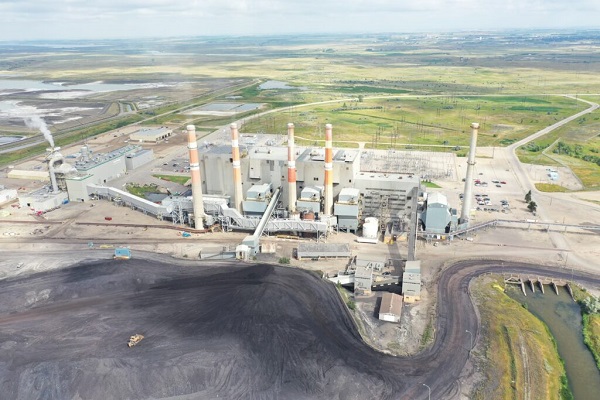Energy
A plan to save coal, power generation, and the oil industry in southeast Saskatchewan

From the Frontier Centre for Public Policy
Stop moving to shut down Saskatchewan coal – it could be the salvation of our oil industry
What if there was a way to keep coal mining jobs in Saskatchewan, continue to produce low-cost electrical power, and extend the production of a substantial portion of Saskatchewan’s oilfields not by decades, but by generations? And in doing so, we could still dramatically reduce carbon dioxide emissions, and maybe save some money by reducing our nuclear rollout?
All of this is now possible, and it has everything to do with keeping our coal miners digging and our coal-fired power plants going, maybe even renewing them.
There was a potentially major development for Saskatchewan’s energy sector buried in Whitecap Resources Inc.’s year-end financial report released on Feb. 21. Whitecap said about using CO2 for enhanced oil recovery, “We have also recently started CO2 injection at a pilot CO2 flood into the Frobisher formation underlying the Weyburn Midale unit. We drilled two (2.0 net) producer wells and three (3.0 net) injection wells in 2023 and initiated CO2 injection in late 2023. Early results are encouraging with a notable production response coming through approximately one month after injection, increasing oil rates on the two producer wells from approximately 40 bpd to over 200 bpd, per well. Further technical analysis to determine commerciality and large-scale development is ongoing, and we will provide updates as next steps are determined.”
While the Bakken formation got all the headlines starting around 2007, the reality is in southeast Saskatchewan, very few Bakken wells are drilled these days. Most of the activity has been Frobisher wells, especially around Steelman, where it has been targeted for decades. So if the Frobisher responds well to tertiary recovery through carbon dioxide floods, it opens up a lot of possibilities for extending the life of some of Saskatchewan’s most prolific oilfields, taking recovery rates from the mid-20 per cent range to over 50 per cent.
Back in 2012, Canadian Natural Resources Limited president and CEO Steve Laut expressed interest in using CO2 for enhanced oil recovery in the Steelman Unit.
Whitecap’s initial results were not a five per cent improvement, or 50 per cent, but five times higher. That’s something everyone, including the provincial government, should take notice of. Imagine if you could increase crop production from 60 bushels to the acre to 300 bushels? Or quintuple potash or uranium production from certain mines? You’d be an idiot to not at least take a hard look at it.
I’m not suggesting it will remain anywhere close to that level, but the fact the CO2 flood in the Weyburn Unit, in the Vuggy and Marly units of the Midale formation, has already dramatically increased recovery rates and lengthened the lifespan of a field that otherwise would have long gone dry is significant. If the same process can be expanded to the much more prolific Frobisher formation, that’s a very big deal.
Even if it was a 25 per cent improvement – that’s well worth investigating.
Frobisher is a big deal
How prolific is the Frobisher?

Most of the drilling activity in southeast Saskatchewan follows a certain pattern. The majority is along the Frobisher subcrop – the edge of the formation where it pinches out, forming a structural trap. Of the 16 rigs working in Saskatchewan on March 3, it’s a good bet 10, and possibly more, were drilling Frobisher wells. The daily well report for March 3 published by the Ministry of Energy and Resources shows out of 19 wells listed that day in Estevan area of responsibility, all 19, across five oil producers, were either targeting the Frobisher. It may be a fluke all that day showed the Frobisher, but it definitely shows its significance.
So if Whitecap, which has been growing to be one of Saskatchewan’s largest oil producers, has found a way to substantially increase production from this formation, shouldn’t we take a hard look at how we can take advantage of it?
Stop the process of winding down coal
There’s one thing we should do right now – stop this idea of shutting down our coal-fired power plants near Estevan. You hardly hear SaskPower mention coal-fired power anymore. I keep hearing how those plants are getting enough maintenance to just get them to the planned phase out of 2030, but not likely a day beyond that. The way things are going, they’ll likely limp to the finish line, but not an inch past that. Similar things are said to me about the mines and their iron.
I’m suggesting we should strongly reconsider that. Pour some money into keeping both the power plants and the mines viable should we choose to extend their lives beyond 2030.
The Government of Saskatchewan and SaskPower should have some real serious discussions with Whitecap, and possibly other oil companies like CNRL, about the possibility of dramatically increasing carbon capture and producing as much CO2 as we can. That means putting carbon capture on Shand Power Station. But it could also mean either refurbishing Boundary Dam Unit 6 or, shockingly, building Shand Unit 2, and maybe even Unit 3, with High Efficiency Low Emissions (HELE) technology, designed from the ground up with carbon capture running from Day 1.
One might say that’s going to cost billions, and you’d be right. But I dare say doing so will cost less than just one 300 megawatt small modular reactor, whose price is not yet known, but previous SaskPower Minister Don Morgan said could run between $3 and $5 billion.
It’s going to take a long time to squeeze the first megawatt out of that first reactor. If everything goes to plan (and it never, ever goes to plan with nuclear), we might see the first SMR megawatt around 2034-35. Putting CCS on our existing coal fleet, and maybe, dare I say, expanding it, with HELE and CCS, could help bridge the gap in the interim until we get several SMRs up and running, and have become proficient in their operation. That’s baseload power that won’t go to zero like wind does every so often, and solar does every night.
Doing so would keep the Estevan economy rolling, not just from coal mining and power generation, but also oil production.
I’ve been writing about the Saskatchewan oil industry for almost 16 years now, and I am increasingly alarmed by the fact I haven’t seen the “next big thing,” in southern Saskatchewan. Drilling numbers keep on their slow decline. Companies like Crescent Point have largely lost interest and are pouring their capital expenditure money into exciting Alberta plays. That may be great for Alberta, but Saskatchewan needs to do something to keep things going here. That we’ve kept oil production relatively flat for the last 23 years is a small miracle. But if we don’t get a lot more new investment, it won’t stay that way.
The Sask Party provincial government a few years ago set a bold goal of increasing oil production from the current 454,000 barrels per day to 600,000 barrels by 2030. I asked Premier Moe about that in my year end interview with him last December. He said he thought it was a modest goal.
But as I pointed out to him, and Energy and Resources Minister Jim Reiter, I’m not seeing evidence of the province moving to make that happen.
This is something the Government of Saskatchewan, through its Crown corporation SaskPower, can do. If we tell the feds to stick it when it comes to shutting down coal by 2030, if we put carbon capture on existing units and even build new coal units with carbon capture, then supply that CO2 to companies like Whitecap, and maybe others like Canadian Natural Resources Limited, we could extend the life of our most prolific play in southeast Saskatchewan. We might even increase its production while we’re at it. All the while, we’d be ensuring baseload power production.
This plan’s impact would be measured in generations, not an election cycle, or a corporate quarter.
And it might also save us some money by reducing our nuclear expenditure.
But action has to be taken now. Because if we let those power plants and mines slide past the point of no return, an opportunity may be lost that we will be kicking ourselves for later.
We can’t let that happen.
Brian Zinchuk is editor and owner of PipelineOnline.ca, and occasional contributor to the Frontier Centre for Public Policy. He can be reached at [email protected].
Alberta
Calls for a new pipeline to the coast are only getting louder

From Resource Works
Alberta wants a new oil pipeline to Prince Rupert in British Columbia.
Calls on the federal government to fast-track new pipelines in Canada have grown. But there’s some confusion that needs to be cleared up about what Ottawa’s intentions are for any new oil and gas pipelines.
Prime Minister Carney appeared to open the door for them when he said, on June 2, that he sees opportunity for Canada to build a new pipeline to ship more oil to foreign markets, if it’s tied to billions of dollars in green investments to reduce the industry’s environmental footprint.
But then he confused that picture by declaring, on June 6, that new pipelines will be built only with “a consensus of all the provinces and the Indigenous people.” And he added: “If a province doesn’t want it, it’s impossible.”
And BC Premier David Eby made it clear on June 2 that BC doesn’t want a new oil pipeline, nor does it want Ottawa to cancel the related ban on oil tankers steaming through northwest BC waters. These also face opposition from some, but not all, First Nations in BC.
Eby’s energy minister, Adrian Dix, also gave thumbs-down to a new oil pipeline, but did say BC supports expanding the capacity of the existing Trans Mountain TMX oil pipeline, and the dredging of Burrard Inlet to allow bigger oil tankers to load Alberta oil from TMX at the port of Vancouver.
While the feds sort out what their position is on fast-tracking new pipelines, Alberta Premier Danielle Smith leaped on Carney’s talk of a new oil pipeline if it’s tied to lowering the carbon impact of the Alberta oilsands and their oil.
She saw “a grand bargain,” with, in her eyes, a new oil pipeline from Alberta to Prince Rupert, BC, producing $20 billion a year in revenue, some of which could then be used to develop and install carbon-capture mechanisms for the oil.
She noted that the Pathways Alliance, six of Canada’s largest oilsands producers, proposed in 2021 a carbon-capture network and pipeline that would transport captured CO₂ from some 20 oilsands facilities, by a new 400-km pipeline, to a hub in the Cold Lake area of Alberta for permanent underground storage.
Preliminary estimates of the cost of that project run up to $20 billion.
The calls for a new oil pipeline from Bruderheim, AB, to Prince Rupert recall the old Northern Gateway pipeline project that was proposed to run from Alberta to Kitimat, BC.
That was first proposed by Enbridge in 2008, and there were estimates that it would mean billions in government revenues and thousands of jobs.
In 2014, Conservative prime minister Stephen Harper approved Northern Gateway. But in 2015, the Federal Court of Appeal overruled the Harper government, ruling that it had “breached the honour of the Crown by failing to consult” with eight affected First Nations.
Then the Liberal government of Prime Minister Justin Trudeau, who succeeded Harper in 2015, effectively killed the project by instituting a ban on oil tanker traffic on BC’s north coast shortly after taking office.
Now Danielle Smith is working to present Carney with a proponent and route for a potential new crude pipeline from Alberta to Prince Rupert.
She said her government is in talks with Canada’s major pipeline companies in the hope that a private-sector proponent will take the lead on a pipeline to move a million barrels a day of crude to the BC coast.
She said she hopes Carney, who won a minority government in April, will make good on his pledge to speed permitting times for major infrastructure projects. Companies will not commit to building a pipeline, Smith said, without confidence in the federal government’s intent to bring about regulatory reform.
Smith also underlined her support for suggested new pipelines north to Grays Bay in Nunavut, east to Churchill, Manitoba, and potentially a new version of Energy East, a proposed, but shelved, oil pipeline to move oil from Alberta and Saskatchewan to refineries and a marine terminal in the Maritimes.
The Energy East oil pipeline was proposed in 2013 by TC Energy, to move Western Canadian crude to an export terminal at St. John, NB, and to refineries in eastern Canada. It was mothballed in 2017 over regulatory hurdles and political opposition in Quebec.
A separate proposal known as GNL Quebec to build a liquefied natural gas pipeline and export terminal in the Saguenay region was rejected by both federal and provincial authorities on environmental grounds. It would have diverted 19.4 per cent of Canadian gas exports to Europe, instead of going to the US.
Now Quebec’s environment minister Benoit Charette says his government would be prepared to take another look at both projects.
The Grays Bay idea is to include an oil pipeline in a corridor that would run from northern BC to Grays Bay in Nunavut. Prime Minister Carney has suggested there could be opportunities for such a pipeline that would carry “decarbonized” oil to new markets.
There have also been several proposals that Canada should build an oil pipeline, and/or a natural gas pipeline, to the port of Churchill. One is from a group of seven senior oil and gas executives who in 2017 suggested the Western Energy Corridor to Churchill.
Now a group of First Nations has proposed a terminal at Port Nelson, on Hudson Bay near Churchill, to ship LNG to Europe and potash to Brazil. And the Manitoba government is looking at the idea.
“There is absolutely a business case for sending our LNG directly to European markets rather than sending our natural gas down to the Gulf Coast and having them liquefy it and ship it over,” says Robyn Lore of project backer NeeStaNan. “It’s in Canada’s interest to do this.”
And, he adds: “The port and corridor will be 100 per cent Indigenous owned.”
Manitoba Premier Wab Kinew has suggested that the potential trade corridor to Hudson Bay could handle oil, LNG, hydrogen, and potash slurry. (One obvious drawback, though, winter ice limits the Hudson Bay shipping season to four months of the year, July to October.)
All this talk of new pipelines comes as Canada begins to look for new markets to reduce reliance on the US, following tariff measures from President Donald Trump.
Alberta Premier Smith says: “I think the world has changed dramatically since Donald Trump got elected in November. I think that’s changed the national conversation.”
And she says that if Carney wants a true nation-building project to fast-track, she can’t think of a better one than a new West Coast oil pipeline.
“I can’t imagine that there will be another project on the national list that will generate as much revenue, as much GDP, as many high paying jobs as a bitumen pipeline to the coast.”
Now we need to know what Mark Carney’s stance on pipelines really is: Is it fast-tracking them to reduce our reliance on the US? Or is it insisting that, for a pipeline, “If a province doesn’t want it, it’s impossible.”
Daily Caller
‘Not Held Hostage Anymore’: Economist Explains How America Benefits If Trump Gets Oil And Gas Expansion


From the Daily Caller News Foundation
Economist Steve Moore appeared on Fox Business Tuesday to discuss what he called the significance of expanding domestic oil and gas production in the United States.
President Donald Trump’s Executive Order 14154 aims to secure U.S. energy independence and global leadership by awarding 10-year oil and gas leases. During an appearance on “The Bottom Line,” Moore said that if Trump’s energy policies succeed then America will no longer have to rely on foreign oil.
“If Trump goes forward with what he wants to do, and our energy secretary is all in on this, produce as much oil and gas as we can here at home in Texas and North Dakota and Oklahoma and these other states. Then we’re not held hostage anymore to what’s happening in the Middle East,” Moore said. “That’s what’s so frustrating. We have more of this stuff than anybody does.”
WATCH:
Moore then pointed to some of former President Joe Biden’s early decisions, particularly the cancellation of pipelines. Moore said these actions left the U.S. vulnerable to external energy crises.
“I don’t want to overemphasize the Strategic Petroleum Reserve. It’s good that we have this sort of safety knot in case you have some kind of blow up in the Middle East, like we have now. But, ultimately, what Joe Biden did was the most sinister of all,” Moore said. “You guys remember what was the first thing when he became president? He canceled pipelines. He destroyed our energy infrastructure.”
During his first term, Trump signed executive orders to advance major pipelines, including instructing TransCanada to resubmit its application for a cross-border permit for the Keystone XL Pipeline, which is designed to transport oil from the tar sands of Alberta, Canada to refineries on the Gulf Coast. On his first day in office, Biden revoked the permit for the Keystone XL Pipeline, effectively halting its development.
-

 Alberta18 hours ago
Alberta18 hours agoAlberta health care blockbuster: Province eliminating AHS Health Zones in favour of local decision-making!
-

 Crime1 day ago
Crime1 day agoUK finally admits clear evidence linking Pakistanis and child grooming gangs
-

 conflict22 hours ago
conflict22 hours agoTrump: ‘We’ have control over Iranian airspace; know where Khomeini is hiding
-

 Health2 days ago
Health2 days agoLast day and last chance to win this dream home! Support the 2025 Red Deer Hospital Lottery before midnight!
-

 Business2 days ago
Business2 days agoCarney praises Trump’s world ‘leadership’ at G7 meeting in Canada
-

 conflict2 days ago
conflict2 days agoIsrael bombs Iranian state TV while live on air
-

 Business1 day ago
Business1 day agoTrump family announces Trump Mobile: Made in America, for America
-

 conflict1 day ago
conflict1 day agoTrump leaves G7 early after urging evacuation of Tehran


